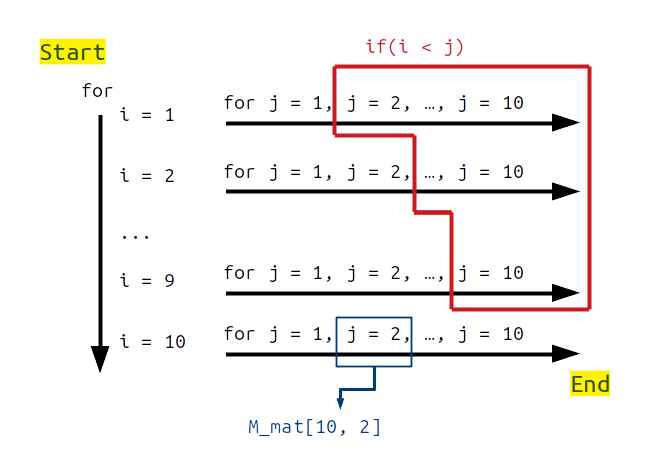


How can we make R look at each row and tell us if an entry is from 1984 Loops are a powerful tool that will let us repeat operations. Be careful, you must set an element on your loop to end it, otherwise you can create an infinite loop. Nested for loops are a common construct, and are often the most time consuming part of R scripts, so they are prime candidates for parallelization. We’ve set up an if/else statement to identify whether the first entry in our table is from 1984, but we want to know that information for all of the entries in our table. The condition is checked at the beginning of the loop.Īs long as the condition is verified, the action on the loop is executed. Write a simple while() loop that reads in an integer. The while loop is a loop based on the respect of a condition. NB: if you have problems with this see the min-exercise in the section Debugging loops. s 10 H zeros(s) for c 1:s for r 1:s H(r,c) 1/(r+c-1) end end. These elements exist in R with two versions: the for loop and the while loop. To iterate over a matrix, we have to define two for loop, namely one for the rows and another for the column.In programming, loops are the elements that allow you to repeat the same action several times. # "Apple" "Orange" "Passion fruit" "Banana"Ī matrix has 2-dimension, rows and columns. Let’s see an exampleįruit <- list(Basket = c('Apple', 'Orange', 'Passion fruit', 'Banana'), 6) Example 5: Break for-Loop Based on Logical Condition. 4) Example 3: Store for-Loop Results in Vector by Appending. Following is an example of for loop in python. 2) Example 1: Loop Through Vector in R (Basics) 3) Example 2: Looping Over Character Vectors. Looping over a list is just as easy and convenient as looping over a vector. For loop- The syntax of for loop is also quite similar in python and R, just keep in mind the points I mentioned in the if, else section above for. To help us detect those values, we can make use of a for loop to iterate over a range of values and define the best candidate. Regularization is a very tedious task because we need to find the value that minimizes the loss function. After we have trained a model, we need to regularize the model to avoid over-fitting. This produces a list, L, whose ith component has the name of the ith column of z and whose content is the regression of the ith column of z.3 answers Top answer: First problem, Im pretty sure the function youre looking for is dynlm(), without the character. The for loop is very valuable for machine learning tasks.

Then you make a numeric vector VAT that is exactly as long as the vector. To do so, you replace the middle section in the function with the following code: You assign the length of the vector client to the variable nclient.

#Writing for loop in r code#
# Create a for statement to populate the list It is not uncommon to wish to run an analysis in R in which one analysis step is repeated with a different variable each time. Using loops in R is very handy, but you can write more efficient code if you loop not over the values but over the indices. For loops in R always iterate over a sequence (a vector), where the length of the vector defines how often the action inside the loop is executed. Fruit <- c('Apple', 'Orange', 'Passion fruit', 'Banana')Įxample 2: creates a non-linear function by using the polynomial of x between 1 and 4 and we store it in a list The simplest and most frequently used type of loops is the for loop.


 0 kommentar(er)
0 kommentar(er)
